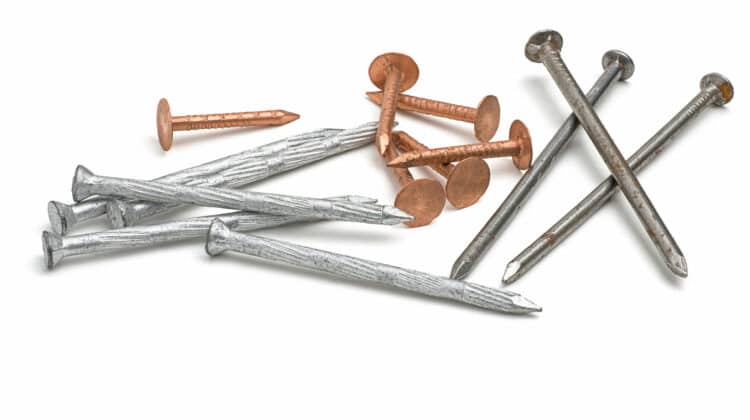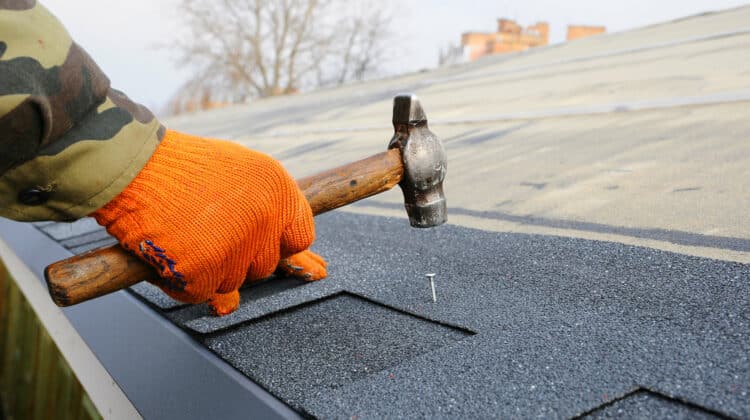Are you curious to learn what size roofing nails should be for your roof?
For an ordinary layperson, roofing nails seem like an insignificant part of a roof and do not matter.
However, professional roofers will disagree since this assumption means the opposite: it is one of the most crucial components in roofing, and without it, the whole roof would collapse.
Even using the wrong size, length, type of nail, or how many per shingle will be a big difference.
Especially the nail size, since it will be used to hammer down shingles, which come in various forms.
To know the appropriate nail size for your roof, you should first learn every type of nail available and their corresponding sizes. This way, you will know what kind to get for your roof.
Table of Contents
What are the different lengths of roofing nails?
Roofing nail lengths are available in one to two inches. Professional roofers look for the correct length because they want the nails to puncture the decking entirely. And it has to be through and through, and the diamond tip will go past the wood.
Thus, you have to carefully plan the shingle and sheathing thickness and also the length of the nail.
For instance, if you are utilizing architectural shingles and three-eighth-inch sheathing, you will require one-inch nails. And if the building code in your area needs thicker sheathing, they require one and one-half inch nails.
If you are installing thicker shingles, you will require longer nails to puncture the decking underneath.
If you are installing hip and ridge shingles, they will require half an inch longer nails since they will need to puncture more layers of shingles.
Classifiyng roofing nails sizes
The old method for classifying roofing nails is called the penny system, which is distinguished by their penny lengths. This system is still present until this day, and some roofing nails are listed as such.
Here is a simple table to assist you in finding the correct roofing nail sizes, if they are only described this way (the letter d is the penny length).
Nail length in inches – Nail length in penny inches
- 1 – 2d
- 1 ¼ – 3d
- 1 ½ – 4d
- 1 ¾ – 5d
- 2 – 6d
What are the common types of roofing nails?
Smooth shank roofing nail
The smooth shank is the most basic nail type and the cheapest. It is the part of the nail that penetrates the wood or other materials you are nailing.
Ring shank roofing nail
Another name of the ring shank is corrugated roofing nail or annular roofing nail. Its distinguishing feature is the many rings along the shank.
It is not the same as screws since the rings are not connected. They provide an extra grip and staying power when nailed on a shingle or sheathing.
The head of all roofing nails has a standard three-eighths diameter. If it is larger, it might expose itself when nailed on a shingle.
Many select this type of nail for its performance and resistance to wind.
Square cap roofing nail
The distinguishing feature of a square cap is the square-shaped head instead of a circular one. It is not used for nailing shingles but for felting underlayment.
This nail type will have either a coiled or smooth shank.
What are the types of roofing nail materials?
When selecting the type of roofing nail material you will use for your roof, you have to be aware that they are situated on the outer portion of the home and be resistant to corrosion.
Some areas have building codes that require the nails to be corrosion-resistant.
Screw shank roofing nail
The distinguishing feature for this type of nail is the screw grooves, which make them look like screws. They are preferred due to their efficient fastening abilities.
Screw shank nails have the highest resistance to withdrawing compared to other types on this list but are seldom used for roofing. There are two reasons: they are more expensive and are difficult to nail into hardwood shingles.
This type is for decking and flooring but is not preferred for roofing.
Steel roofing nail
Steel is the strongest material for nails and has protection from corrosion and rust. Steel nails are classified into two:
- Stainless steel – This type is used for ceramic, slate, or asphalt roofing in coastal regions.
- Galvanized steel – This type includes a layer of zinc to the steel for corrosion and rust protection.
There are two methods to galvanize these nails: electro-galvanized and hot-dipped. The hot-dipped is preferable because of a thicker zinc layer and for roofing asphalt shingles.
Copper roofing nail
Copper nails are strong and also corrosion and rust-resistant. Many prefer this type for roofing copper flashing and its accessories.
Since roofing nails cannot be seen once nailed through the shingles, some still use steel nails since they are stronger and do not detract from the roof’s appearance.
Aluminum roofing nail
Aluminum nails are the most feeble material for roofing and are prone to corrosion, salt, and chemical damage.
Yet some roofers still use them for asphalt shingle roofing.
What are the tools used for roofing nails?
Since you now have the necessary information about roofing nails, you will need the appropriate tools for them:
Use a hammer, cordless and pneumatic nailer to drive down the nails
The hammer is the most common tool to drive down the nails and is effective for shingles.
The cordless roofing nailer functions with batteries, similar to a string trimmer and leaf blower. It is easy to handle, convenient, and enables one hand free.
A pneumatic roofing nailer is also effective but needs to be handled carefully since not doing so can result in under or overdriven nails.
Use a ladder for climbing
A ladder is essential since you need a tool for climbing up the roof to drive in nails. You have to make sure you also have roof ladder hooks to secure it in position to keep accidents from occurring.
Use cleanup tools for cleaning the roof
After the roofing job is over, you will need to clean the area. A broom can do the job, but a magnetic sweeper is better since it can pick up metal shavings, loose nails, and other metallic debris left behind.
FAQ or frequently asked questions about what size roofing nails you need
What is the best type of nails to use for shingles?
The best kind for shingles is hot-dipped galvanized steel ring roofing nails. Its length and size will depend on the type of shingles and the thickness of the sheathing.
What are the best nails to use for underlayment or felt?
The roofing underlayment or felt are installed underneath the shingles, which have to be driven down by roofing cap nails.
Roofing cap nails have plastic caps for heads that prohibit water from seeping in.
What is the best type of nails for roof flashing?
Professional roofers use the available nails for installing flashing. There is no specific material for this type, and any nails will suffice.
What is the best type of nails for sheathing?
For nailing the decking to the roof truss, you can use regular steel smooth shank nails or wood screws. However, you should also check on your local bylaws and building code to be sure.
Can you reuse roofing nails?
It is not a good idea to reuse old nails. The zinc coating will be scraped off and maybe rusty and corrosive.
They might also be bent and damaged and might cause problems in the future, so it is always better to throw away the old ones and use brand new nails.
Can you use staples for roofing?
You can use staples for installing ice and water shield and underlayment, but not for shingles.
Staples have extremely low holding power and will end up in disaster if used for shingles.
What size roofing nails are the best to use for your home?
The nail size, type, and material are crucial for roofing purposes, so if you are still uncertain of the proper nails to use, consult a professional roofer.
This way, you ensure that your roof will be strong, sturdy, and withstand harsh weather elements. You and your family’s protection should be your utmost concern.





